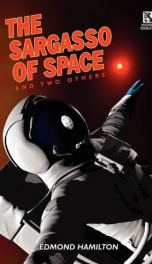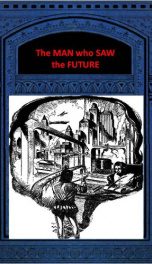Hamilton Edmond

Edmond Moore Hamilton (October 21, 1904 - February 1, 1977) was a popular author of science fiction stories and novels during the mid-twentieth century.[1] Born in Youngstown, Ohio, he was raised there and in nearby New Castle, Pennsylvania. Something of a child prodigy, he graduated from high school and started college (Westminster College, New Wilmington, Pennsylvania) at the age of 14–but washed out at 17. Edmond is credited as the author of the first hardcover compilation of what would eventually come to be known as the science fiction genre, The Horror on The Asteroid and Other Tales of Planetary Horror (1936). The book compiles the following stories: "The Horror on the Asteroid", “The Accursed Galaxy", "The Man Who Saw Everything" ("The Man With the X-Ray Eyes"), "The Earth-Brain", "The Monster-God of Mamurth", and "The Man Who Evolved". His career as a science fiction writer began with the publication of the short story "The Monster God of Mamurth",[2] which appeared in the August 1926 issue of the classic magazine of alternative fiction, Weird Tales. Hamilton quickly became a central member of the remarkable group of Weird Tales writers assembled by editor Farnsworth Wright, that included H. P. Lovecraft and Robert E. Howard. Hamilton would publish 79 works of fiction in Weird Tales between 1926 and 1948, making him one of the most prolific of the magazine's contributors (only Seabury Quinn and August Derleth appeared more frequently). Hamilton became a friend and associate of several Weird Tales veterans, including E. Hoffmann Price and Otis Adelbert Kline; most notably, he struck up a 20-year friendship with close contemporary Jack Williamson, as Williamson records in his 1984 autobiography Wonder's Child. In the late 1930s Weird Tales printed several striking fantasy tales by Hamilton, most notably "He That Hath Wings" (July 1938), one of his most popular and frequently-reprinted pieces. Through the late 1920s and early '30s Hamilton wrote for all of the SF pulp magazines then publishing, and contributed horror and thriller stories to various other magazines as well. He was very popular as an author of space opera, a sub-genre he created along with E.E. "Doc" Smith. His story "The Island of Unreason" (Wonder Stories, May 1933) won the first Jules Verne Prize as the best SF story of the year (this was the first SF prize awarded by the votes of fans, a precursor of the later Hugo Awards). In the later 1930s, in response to the economic strictures of the Great Depression, he also wrote detective and crime stories. Always prolific in stereotypical pulp-magazine fashion, Hamilton sometimes saw 4 or 5 of his stories appear in a single month in these years; the February 1937 issue of the pulp Popular Detective featured three Hamilton stories, one under his own name and two under pseudonyms. In the 1940s, Hamilton was the primary force behind the Captain Future franchise,[3] an SF pulp designed for juvenile readers that won him many fans, but diminished his reputation in later years when science fiction moved away from its space-opera roots. Hamilton was always associated with an extravagant, romantic, high-adventure style of SF, perhaps best represented by his 1947 novel The Star Kings. As the SF field grew more sophisticated, his brand of extreme adventure seemed ever more quaint, corny, and dated. In 1946 Hamilton began writing for DC Comics, specializing in stories for their characters Superman [4] and Batman. One of his best known Superman stories was "Superman Under the Red Sun" which appeared in Action Comics #300 in 1963 and which has numerous elements in common with his novel City At World's End[5] (1951). He wrote other works for DC Comics, including the short-lived science fiction series Chris KL-99 (in Strange Adventures), which was loosely based on his Captain Future character. He retired from comics in 1966. On December 31, 1946, Hamilton married fellow science fiction author and screen writer Leigh Brackett in San Gabriel, CA, and moved with her to Kinsman, Ohio. Afterward he would produce some of his best work, including his novels The Star of Life (1947), The Valley of Creation (1948), City at World's End, and The Haunted Stars (1960). In this more mature phase of his career, Hamilton moved away from the romantic and fantastic elements of his earlier fiction to create some unsentimental and realistic stories, such as "What's It Like Out There?" (Thrilling Wonder Stories, Dec. 1952), his single most frequently-reprinted and anthologized work. Though Hamilton and Leigh Brackett worked side by side for a quarter-century, they rarely shared the task of authorship; their single formal collaboration, Stark and the Star Kings, would not appear in print until 2005. In the early 1960s, when Brackett had temporarily abandoned SF for screenwriting, Hamilton did an uncredited revision and expansion of two early Brackett stories, "Black Amazon of Mars" and "Queen of the Martian Catacombs"--the results were published as her novellas People of the Talisman and The Secret of Sinharat (1964). Edmond Hamilton died in 1977 in Lancaster, California, of complications following kidney surgery. In the year before his death he had worked on an anime adaptation of his Captain Future novels and a tokusatsu adaptation of Star Wolf; both appeared on Japanese television in 1978 and the Captain Future adaptation later played in Europe, winning Hamilton a new and different fan base than the one that had acclaimed him half a century before. In 2009, Kinsman Ohio celebrates "Edmond Hamilton Day" on July 18.[1]
do you like this author?
What readers are saying
What do you think? Write your own comment on this book!
write a commentWhat readers are saying
What do you think? Write your own comment on this author!
write a commentBook list

The Sargasso of Space
Series:
Unknown
Year:
Unknown
Raiting:
1/5
In the tradition of the old "Ace Doubles" two-in-one books (flip one over to read the second title) -- here is the first Wildside Double . . . "The Sargasso of Space and Two Others," by Edmond Hamilton and "The Copper-Clad World," by Harl Vincent. Two oldtime science fiction authors at their galaxy-spanning best!
Show more
add to favoritesadd In favorites

The Man Who Saw the Future
Series:
Unknown
Year:
Unknown
Raiting:
2/5
The MAN who SAW the FUTUREBy EDMOND HAMILTON
Show more
add to favoritesadd In favorites

The Stars, My Brothers
Series:
Unknown
Year:
Unknown
Raiting:
1.5/5
The pilot was Lieutenant Charles Wandek, UNRC, home address: 1677 Anstey Avenue, Detroit. He did not survive the crash of his ferry into Wheel Five. Neither did his three passengers, a young French astrophysicist, an East Indian expert on magnetic fields, and a forty-year-old man from Philadelphia who was coming out to replace a pump technician.
A short story by Edmond Moore Hamilton, a prolific American author of science fiction stories and novels during the mid-twentieth century.
Show more
add to favoritesadd In favorites
A short story by Edmond Moore Hamilton, a prolific American author of science fiction stories and novels during the mid-twentieth century.
Show more
Book list

The Sargasso of Space
Series:
Unknown
Year:
Unknown
Raiting:
1/5
In the tradition of the old "Ace Doubles" two-in-one books (flip one over to read the second title) -- here is the first Wildside Double . . . "The Sargasso of Space and Two Others," by Edmond Hamilton and "The Copper-Clad World," by Harl Vincent. Two oldtime science fiction authors at their galaxy-spanning best!
Show more
add to favoritesadd In favorites

The Man Who Saw the Future
Series:
Unknown
Year:
Unknown
Raiting:
2/5
The MAN who SAW the FUTUREBy EDMOND HAMILTON
Show more
add to favoritesadd In favorites

The Stars, My Brothers
Series:
Unknown
Year:
Unknown
Raiting:
1.5/5
The pilot was Lieutenant Charles Wandek, UNRC, home address: 1677 Anstey Avenue, Detroit. He did not survive the crash of his ferry into Wheel Five. Neither did his three passengers, a young French astrophysicist, an East Indian expert on magnetic fields, and a forty-year-old man from Philadelphia who was coming out to replace a pump technician.
A short story by Edmond Moore Hamilton, a prolific American author of science fiction stories and novels during the mid-twentieth century.
Show more
add to favoritesadd In favorites
A short story by Edmond Moore Hamilton, a prolific American author of science fiction stories and novels during the mid-twentieth century.
Show more
What readers are saying
What do you think? Write your own comment on this author!
write a commentif you like Hamilton Edmond try:
readers also enjoyed
What readers are saying
What do you think? Write your own comment on this author!
write a commentGenre
if you like Hamilton Edmond try:
readers also enjoyed
Do you want to read a book that interests you? It’s EASY!
Create an account and send a request for reading to other users on the Webpage of the book!

